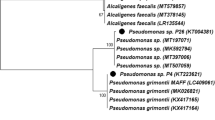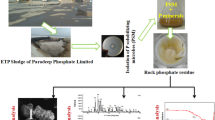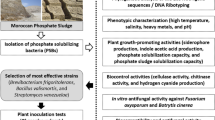Abstract
Microbial solubilization of rock phosphate (RP) considered being an alternative to chemical phosphorous (P) fertilizer, causing high costs and environmental pollution. This work aimed to isolate efficient phosphate solubilizing strains from the estuary region of the Mahanadi river to check their RP solubilizing efficiency, and the mechanisms were discussed. Two strains of bacteria (Bacillus thuringenesis P0B11 and Lysinobaccillus fusiformis P0B28) and a fungus (Aspergillus aculeatus P0F3) were the most effective strain solubilizing RP. This is the first report of RP solubilization by L. fusiformis P0B28 and the first report of in vitro stearic acid production during RP solubilization. In particular, the potent strain A. aculeatus P0F3 produced the highest soluble P (345.6 mg/l) on 5th day. The soluble P concentration showed a significant negative correlation (r = − 0.88, p ≤ 0.01) with the pH, while it is positively correlated with the growth of B. thuringenesis P0B11 (r = 0.87, p ≤ 0.01), L. fusiformis P0B28 (r = 0.55, p ≤ 0.01) and A. aculeatus P0F3 (r = 0.96, p ≤ 0.01), respectively. The P release process from rock phosphate fit the first-order kinetics model well (R2 = 0.8046–0.8401). Organic acids produced by the isolates found to be the major mechanism for RP solubilization by supplying H+ ions and organic anions. High P concentration was related to the high corroded structure formation on the RP surface, reduction in all mineral peak intensities and a large decrease in the intensity of vibrational bands of calcite and fluorapatite confirmed by SEM, XRD, and FTIR, respectively.
Graphic abstract

Article Highlights
-
Effective rock phosphate (RP) solubilization by Bacillus thuringenesis P0B11, Lysinobaccillus fusiformis P0B28, and Aspergillus aculeatus P0F3 isolated from Mahanadi estuary of Odisha, India.
-
First report of RP solubilization by L. fusiformis P0B28. First report of in vitro stearic acid production during RP solubilization.
-
Organic acids were the major mechanism for RP solubilization and responsible for morphological and mineralogical changes confirmed by SEM, XRD and FTIR, respectively.






Similar content being viewed by others
References
Achal V, Savant VV, Reddy MS (2007) Phosphate solubilization by a wild type strain and UV-induced mutants of Aspergillus tubingensis. Soil Biol Biochem 39:695–699. https://doi.org/10.1016/j.soilbio.2006.09.003
Alori ET, Glick BR, Babalola OO (2017) Microbial phosphorus solubilization and its potential for use in sustainable agriculture. Front Microbiol 8:971. https://doi.org/10.3389/fmicb.2017.00971
Arora D, Gaur AC (1979) Microbial solubilization of different inorganic phosphates. Short communication. Indian J Exp Biol 11:1258–1261
Banik S, Dey BK (1982) Available phosphate content of an alluvial soil as influenced by inoculation of some isolated phosphate-solubilizing micro-organisms. Plant Soil 69(3):353–364. https://doi.org/10.2307/42934143
Bhattacharjya S, Adhikari T, Kundu S, Sahu AK, Patra A (2019) Evaluation of microbial solubilisation of nano rock phosphate. Int J Curr Microbiol Appl Sci 8:1055–1069. https://doi.org/10.20546/ijcmas.2019.801.115
Bojinova D, Velkova R, Ivanova R (2008) Solubilization of Morocco phosphorite by Aspergillus niger. Bioresour Technol 99:7348–7353. https://doi.org/10.1016/j.biortech.2007.08.047
Böttcher ME, Gehlken PL, Steele DF (1997) Characterization of inorganic and biogenic magnesian calcites by Fourier transform infrared spectroscopy. Solid State Ion 101–103:1379–1385. https://doi.org/10.1016/s0167-2738(97)00235-x
Bray RH, Kurtz LT (1945) Determination of total, organic, and available forms of phosphorus in soils. Soil Sci 59:39–45
Chen YP, Rekha PD, Arun AB, Shen FT, Lai WA, Young CC (2006) Phosphate solubilizing bacteria from subtropical soil and their tricalcium phosphate solubilizing abilities. Appl Soil Ecol 34:33–41. https://doi.org/10.1016/j.apsoil.2005.12.002
Chen Y, Fan JB, Du L, Xu H, Zhang QH, He YQ (2014) The application of phosphate solubilizing endophyte Pantoea dispersa triggers the microbial community in red acidic soil. Appl Soil Ecol 84:235–244. https://doi.org/10.1016/j.apsoil.2014.05.014
Chi RA, Xiao CQ, Gao H, Wu Y, Li XS, Wang RCW (2005) Biodecomposition of low-grade rock phosphate with some bacteria and fungi. Chin J Process Eng 6:636–639
Congeevaram S, Dhanarani S, Park J, Dexilin M, Thamaraiselvi K (2007) Biosorption of chromium and nickel by heavy metal resistant fungal and bacterial isolates. J Hazard Mater 146(1–2):270–277
Das J, Das SN, Sahoo RK (1997) Semidiurnal variation of some physico-chemical parameters in the Mahanadi estuary, east coast of India. Indian J Mar Sci 26:323–326
De Oliveira MG, Moreira De Freitas AL, Liparini Pereira O, Ribeiro Da Silva I, Bojkov Vassilev N, Dutra Costa M (2014) Mechanisms of phosphate solubilization by fungal isolates when exposed to different P sources. Ann Microbiol 64:239–249. https://doi.org/10.1007/s13213-013-0656-3
De Oliveira MG, Murta HM, Valadares RV, da Silveira WB, da Silva IR, Costa MD (2020) Oxalic acid is more efficient than sulfuric acid for rock phosphate solubilization. Min Eng 155:106458
Delvasto P, Valverde A, Ballester A, Igual JM, Muñoz JA, González F, Blázquez ML, García C (2006) Characterization of brushite as a re-crystallization product formed during bacterial solubilization of hydroxyapatite in batch cultures. Soil Biol Biochem 38:2645–2654. https://doi.org/10.1016/j.soilbio.2006.03.020
Dorozhkin SV (2002) A review on the dissolution models of calcium apatites. Prog Cryst Growth Charact Mater 44:45–61. https://doi.org/10.1016/S0960-8974(02)00004-9
Gaur A, Madan M (1973) Solubilization of phosphatic compounds by native microflora of rock phosphates. Indian J Exp Biol 11(5):427–429
Girgis MGZ, Khalil HM, Ajb MS (2008) In vitro evaluation of rock phosphate and potassium solubilizing potential of some Bacillus strains. Aust J Basic Appl Sci 2(1):68–81
Goenadi DH, Sugiarto Y (2000) Bioactivation of poorly soluble phosphate rocks with a phosphorus-solubilizing fungus. Soil Sci Soc Am J 64:927–932. https://doi.org/10.2136/sssaj2000.643927x
Goldstein AH (1994) Involvement of the quinoprotein glucose dehydrogenises in the solubilization of exogenous phosphates by gram-negative bacteria. In: Phosphate in microorganisms: cellular and molecular biology. ASM Press, Washington, DC, pp 197–203
Gomes EA, Silva UC, Marriel IE, Oliveira CA, Lana UGP (2014) Rock phosphate solubilizing microorganisms isolated from maize rhizosphere soil. Rev Bras Milho e Sorgo 13:69–81. https://doi.org/10.18512/1980-6477/rbms.v13n1p69-81
Gulati A, Sharma N, Vyas P, Sood S, Rahi P, Pathania V, Prasad R (2010) Organic acid production and plant growth promotion as a function of phosphate solubilization by Acinetobacter rhizosphaerae strain BIHB 723 isolated from the cold deserts of the trans-Himalayas. Arch Microbiol 192:975–983. https://doi.org/10.1007/s00203-010-0615-3
Gupta N, Sabat J, Parida R, Kerkatta D (2007) Solubilization of tricalcium phosphate and rock phosphate by microbes isolated from chromite, iron and manganese mines. Acta Bot Croat 66:197–204
Halder AK, Mishra AK, Bhattacharyya P, Chakrabartty PK (1990) Solubilization of rock phosphate by Rhizobium and Bradyrhizobium. J Gen Appl Microbiol 36:81–92. https://doi.org/10.2323/jgam.36.81
Hamdali H, Bouizgarne B, Hafidi M, Lebrihi A, Virolle MJ, Ouhdouch Y (2008) Screening for rock phosphate solubilizing Actinomycetes from Moroccan phosphate mines. Appl Soil Ecol 38:12–19. https://doi.org/10.1016/j.apsoil.2007.08.007
Hassimi MS, Hamdali H, Ouhdouch Y, Pinelli E, Merlina G, Claude RJ, Hafidi M (2013) Moroccan rock phosphate solubilization during a thermo-anaerobic grassland waste biodegradation process. Afr J Biotechnol 12:6859–6865
Hughes JM, Rakovan J (2019) The crystal structure of apatite, Ca5(PO4)3(F,OH,Cl). In: Phosphates: geochemical, geobiological and materials importance. De Gruyter Mouton, pp 1–12. https://doi.org/10.2138/rmg.2002.48.1
Illmer P, Schinner F (1995) Solubilization of inorganic calcium phosphates—solubilization mechanisms. Soil Biol Biochem 27:257–263. https://doi.org/10.1016/0038-0717(94)00190-C
Ivanova RP, Bojinova DY, Gruncharov IN, Damgaliev DL (2006) The solubilization of rock phosphate by organic acids. Phosphorus Sulfur Silicon Relat Elem 181:2541–2554. https://doi.org/10.1080/10426500600758399
Khalil S (1995) Direct application of phosphate rock and appropriate technology fertilizers in Pakistan. In: Proc International workshop, direct application of rock phosphate and appropriate technology fertilizers in Asia-What hinders acceptance and growth, Kandy, Sri Lanka, pp 231–236
Khan R, Shahzad S, Choudhary MI, Khan SA, Ahmad A (2010) Communities of endophytic fungi in medicinal plant Withania somnifera. Pak J Bot 42(2):1281–1287
Kpomblekou-A K, Tabatabai MA (1994) Effect of organic acids on release of phosphorus from phosphate rocks. Soil Sci 158:442–453. https://doi.org/10.1097/00010694-199415860-00006
Kucey RMN (1983) Phosphate-solubilizing bacteria and fungi in various cultivated and virgin Alberta soils. Can J Soil Sci 63:671–678
Kumari A, Kapoor KK, Kundu BS, Mehta RK (2008) Identification of organic acids produced during rice straw decomposition and their role in rock phosphate solubilization. Plant Soil Environ 54:72–77. https://doi.org/10.17221/2783-pse
Li L, Lv Z, Zuo Z, Yang Z, Yuan X (2016a) Effect of energy source and leaching method on bio-leaching of rock phosphates by Acidithiobacillus ferrooxidans. Hydrometallurgy 164:238–247. https://doi.org/10.1016/j.hydromet.2016.06.018
Li Z, Wang F, Bai T, Tao J, Guo J, Yang M, Wang S, Hu S (2016b) Lead immobilization by geological fluorapatite and fungus Aspergillus niger. J Hazard Mater 320:386–392. https://doi.org/10.1016/j.jhazmat.2016.08.051
Li L, Chen R, Zuo Z, Lv Z, Yang Z, Mao W, Liu Y, Zhou Y, Huang J, Song Z (2020) Evaluation and improvement of phosphate solubilization by an isolated bacterium Pantoea agglomerans ZB. World J Microbiol Biotechnol 36(2):27. https://doi.org/10.1007/s11274-019-2744-4
Lopez JE, Gallego JL, Vargas-Ruiz A, Peña-Mosquera AL, Zapata-Zapata AD, López-Sánchez IJ, Botero-Botero LR (2020) Aspergillus tubingensis and Talaromyces islandicus solubilize rock phosphate under saline and fungicide stress and improve Zea mays growth and phosphorus nutrition. J Soil Sci Plant Nutr 20(4):2490–2501
Mandal SK, Majumder N, Chowdhury C, Jana TK, Dutta B (2016) Arsenic distribution in waters and its geochemical behavior in sediment of Mahanadi estuary in India. Environ Monit Assess 188:1–7. https://doi.org/10.1007/s10661-016-5471-4
Mattey M (1992) The production of organic acids. Crit Rev Biotechnol 12:87–132. https://doi.org/10.3109/07388559209069189
Michoustine E (1972) Processus microbiologiques mobilisant les composés du phosphore dans le sol. Rev Ecol Biol Sol 9(3):521–528
Mohapatra A, Rautray TR, Patra AK, Vijayan V, Mohanty RK (2009) Elemental composition in mud crab Scylla serrata from Mahanadi estuary, India: in situ irradiation analysis by external PIXE. Food Chem Toxicol 47:119–123. https://doi.org/10.1016/j.fct.2008.10.016
Nahas E (1996) Factors determining rock phosphate solubilization by microorganisms isolated from soil. World J Microbiol Biotechnol 12:567–572. https://doi.org/10.1007/BF00327716
Naik S, Acharya BC, Mohapatra A (2009) Seasonal variations of phytoplankton in Mahanadi estuary, east coast of India. Indian J Geo-Mar Sci 38(2):184–190
Narsian V, Patel HH (2000) Aspergillus aculeatus as a rock phosphate solubilizer. Soil Biol Biochem 32:559–565. https://doi.org/10.1016/S0038-0717(99)00184-4
Omar SA (1997) The role of rock-phosphate-solubilizing fungi and vesicular-arbusular-mycorrhiza (VAM) in growth of wheat plants fertilized with rock phosphate. World J Microbiol Biotechnol 14:211–218. https://doi.org/10.1023/A:1008830129262
Ouahmane L, Thioulouse J, Hafidi M, Prin Y, Ducousso M, Galiana A, Plenchette C, Kisa M, Duponnois R (2007) Soil functional diversity and P solubilization from rock phosphate after inoculation with native or allochtonous arbuscular mycorrhizal fungi. For Ecol Manag 241:200–208. https://doi.org/10.1016/j.foreco.2007.01.015
Papagianni M (2007) Advances in citric acid fermentation by Aspergillus niger: biochemical aspects, membrane transport and modeling. Biotechnol Adv 25(3):244–263. https://doi.org/10.1016/j.biotechadv.2007.01.002
Park JH, Bolan N, Megharaj M, Naidu R (2011) Isolation of phosphate solubilizing bacteria and their potential for lead immobilization in soil. J Hazard Mater 185:829–836. https://doi.org/10.1016/j.jhazmat.2010.09.095
Paz A, Guadarrama D, López M, González JE, Brizuela N, Aragón J (2012) A comparative study of hydroxyapatite nanoparticles synthesized by different routes. Quim Nova 35:1724–1727. https://doi.org/10.1590/S0100-40422012000900004
Pikovskaya RI (1948) Mobilization of phosphorus in soil in connection with vital activity of some microbial species. Microbiologia 17:362–370
Poi SC (1986) A study of performance of some phosphate-solubilizing microorganisms in presence of some energy sources. Zentralbl Mikrobiol 141:97–102. https://doi.org/10.1016/s0232-4393(86)80022-1
Pradhan UK, Shirodkar PV, Sahu BK (2009) Physico-chemical characteristics of the coastal water off Devi estuary, Orissa and evaluation of its seasonal changes using chemometric techniques. Curr Sci 96:1203–1209. https://doi.org/10.2307/24105409
Prasad PSR, Chaitanya VK, Prasad KS, Rao DN (2005) Direct formation of the γ-CaSO4 phase in dehydration process of gypsum: in situ FTIR study. Am Mineral 90:672–678. https://doi.org/10.2138/am.2005.1742
Rajan SSS (1983) Effect of sulphur content of phosphate rock/sulphur granules on the availability of phosphate to plants. Fertil Res 4:287–296. https://doi.org/10.1007/BF01049485
Ranjan Dixit P, Kar B, Chattopadhyay P, Ranjan Panda C (2013) Seasonal variation of the physicochemical properties of water samples in Mahanadi Estuary, East Coast of India. J Environ Prot (Irvine, Calif) 4:843–848. https://doi.org/10.4236/jep.2013.48098
Rashid M, Khalil S, Ayub N, Alam N, Latif F (2004) Organic acids production and phosphate solubilization by phosphate solubilizing microorganisms (PSM) under in vitro condition. Pak J Biol Sci 7:187–196. https://doi.org/10.3923/pjbs.2004.187.196
Ray SB, Mohanti M, Somayajulu BLK (1984) Suspended matter, major cations and dissolved silicon in the estuarine waters of the Mahanadi River, India. J Hydrol 69:183–196. https://doi.org/10.1016/0022-1694(84)90163-X
Ray SB, Mohanti M, Somayajulu BLK (1995) Uranium isotopes in the Mahanadi river-estuarine system, India. Estuar Coast Shelf Sci 40:635–645. https://doi.org/10.1006/ecss.1995.0043
Reddy MS, Kumar S, Babita K, Reddy MS (2002) Biosolubilization of poorly soluble rock phosphates by Aspergillus tubingensis and Aspergillus niger. Bioresour Technol 84:187–189. https://doi.org/10.1016/S0960-8524(02)00040-8
Reyes I, Bernier L, Simard RR, Antoun H (1999) Effect of nitrogen source on the solubilization of different inorganic phosphates by an isolate of Penicillium rugulosum and two UV-induced mutants. FEMS Microbiol Ecol 28:281–290. https://doi.org/10.1111/j.1574-6941.1999.tb00583.x
Reyes I, Bernier L, Antoun H (2002) Rock phosphate solubilization and colonization of maize rhizosphere by wild and genetically modified strains of Penicillium rugulosum. Micro Eco 44(1):39–48
Rinu K, Pandey A (2011) Slow and steady phosphate solubilization by a psychrotolerant strain of Paecilomyceshepiali (MTCC 9621). World J Microbiol Biotechnol 27(5):1055–1062
Rodríguez H, Fraga R (1999) Phosphate solubilizing bacteria and their role in plant growth promotion. Biotechnol Adv 17:319–339. https://doi.org/10.1016/S0734-9750(99)00014-2
Sahu SN, Jana BB (2000) Enhancement of the fertilizer value of rock phosphate engineered through phosphate-solubilizing bacteria. Ecol Eng 15:27–39. https://doi.org/10.1016/S0925-8574(99)00013-0
Saikia BJ, Parthasarathy G, Sarmah NC (2008) Fourier transform infrared spectroscopic estimation of crystallinity in SiO2 based rocks. Bull Mater Sci 31:775–779. https://doi.org/10.1007/s12034-008-0123-0
Selvakumar G, Joshi P, Suyal P, Mishra PK, Joshi GK, Venugopalan R, Kumar Bisht J, Bhatt JC, Gupta HS (2013) Rock phosphate solubilization by psychrotolerant Pseudomonas spp. and their effect on lentil growth and nutrient uptake under polyhouse conditions. Ann Microbiol 63:1353–1362. https://doi.org/10.1007/s13213-012-0594-5
Selvi KB, Paul JJA, Vijaya V, Saraswathi K (2017) Analyzing the efficacy of phosphate solubilizing microorganisms by enrichment culture techniques. Biochem Mol Biol J 3:1–7. https://doi.org/10.21767/2471-8084.100029
Shin D, Kim J, Kim BS, Jeong J, Lee JC (2015) Use of phosphate solubilizing bacteria to leach rare earth elements from monazite-bearing ore. Minerals 5(2):189–202. https://doi.org/10.3390/min5020189
Shrivastava M, Kale SP, D’Souza SF (2011) Rock phosphate enriched post-methanation bio-sludge from kitchen waste based biogas plant as P source for mungbean and its effect on rhizosphere phosphatase activity. Eur J Soil Biol 47:205–212. https://doi.org/10.1016/j.ejsobi.2011.02.002
Sundaray SK, Panda UC, Nayak BB, Bhatta D (2006) Multivariate statistical techniques for the evaluation of spatial and temporal variations in water quality of the Mahanadi river-estuarine system (India)—a case study. Environ Geochem Health 28:317–330. https://doi.org/10.1007/s10653-005-9001-5
Sundaray SK, Nayak BB, Bhatta D (2009) Environmental studies on river water quality with reference to suitability for agricultural purposes: Mahanadi river estuarine system, India—a case study. Environ Monit Assess 155:227–243. https://doi.org/10.1007/s10661-008-0431-2
Sundaray SK, Nayak BB, Lin S, Bhatta D (2011) Geochemical speciation and risk assessment of heavy metals in the river estuarine sediments—a case study: Mahanadi basin, India. J Hazard Mater 186:1837–1846. https://doi.org/10.1016/j.jhazmat.2010.12.081
Tuovinen OH, Bhatti TM, Bigham JM, Hallberg KB, Garcia O, Lindstrom EB (1994) Oxidative dissolution of arsenopyrite by mesophilic and moderately thermophilic acidophiles. Appl Environ Microbiol 60:3268–3274. https://doi.org/10.1128/aem.60.9.3268-3274.1994
Vassilev N, Vassileva M (2003) Biotechnological solubilization of rock phosphate on media containing agro-industrial wastes. Appl Microbiol Biotechnol 61(5–6):435–440. https://doi.org/10.1007/s00253-003-1318-3
Vassilev N, Franco I, Vassileva M, Azcon R (1996) Improved plant growth with rock phosphate solubilized by aspergillus niger grown on sugar-beet waste. Bioresour Technol 55:237–241. https://doi.org/10.1016/0960-8524(96)00008-9
Vassilev N, Vassileva M, Nikolaeva I (2006) Simultaneous P-solubilizing and biocontrol activity of microorganisms: potentials and future trends. Appl Microbiol Biotechnol 71(2):137–144. https://doi.org/10.1007/s00253-006-0380-z
Vassilev N, Nikolaeva I, Vassileva M (2007) Indole-3-acetic acid production by gel-entrapped bacillus thuringiensis in the presence of rock phosphate ore. Chem Eng Commun 194:441–445. https://doi.org/10.1080/00986440600983486
Vyas P, Gulati A (2009) Organic acid production in vitro and plant growth promotion in maize under controlled environment by phosphate-solubilizing fluorescent Pseudomonas. BMC Microbiol 9(1):174. https://doi.org/10.1186/1471-2180-9-174
Wei Y, Zhao Yue Fan Y, Lu Q, Li M, Wei Q, Yi Z, Cao Z, Wei Z (2017) Impact of phosphate-solubilizing bacteria inoculation methods on phosphorus transformation and long-term utilization in composting. Bioresour Technol 241:134–141. https://doi.org/10.1016/j.biortech.2017.05.099
Wei Y, Zhao Y, Shi M, Cao Z, Lu Q, Yang T, Fan Y, Wei Z (2018) Effect of organic acids production and bacterial community on the possible mechanism of phosphorus solubilization during composting with enriched phosphate-solubilizing bacteria inoculation. Bioresour Technol 247:190–199. https://doi.org/10.1016/j.biortech.2017.09.092
Xiao CQ, Chi RA, Fang YJ (2013) Effects of Acidiphilium cryptum on biosolubilization of rock phosphate in the presence of Acidithiobacillus ferrooxidans. Trans Nonferrous Metals Soc China 23(7):2153–2159
Xiao C, Wu X, Liu T, Xu G, Chi R (2017) Microbial community structure of activated sludge for biosolubilization of two different rock phosphates. Appl Biochem Biotechnol 182:742–754. https://doi.org/10.1007/s12010-016-2358-3
Yadav H, Fatima R, Sharma A, Mathur S (2017) Enhancement of applicability of rock phosphate in alkaline soils by organic compost. Appl Soil Ecol 113:80–85. https://doi.org/10.1016/j.apsoil.2017.02.004
Zaidi A, Khan MS, Ahemad M, Oves M, Wani PA (2009) Recent advances in plant growth promotion by phosphate-solubilizing microbes. In: Micro strat for crop impro. Sprin-Verl, Berlin, pp 23–50. https://doi.org/10.1007/978-3-642-01979-1_2
Acknowledgements
AcSIR Ph.D. student, Ms. Rojali Maharana expresses thanks to the Department of Science and Technology, Govt of India, for providing INSPIRE fellowship (DST/INSPIRE/03/2015/000438, IF160155), and CSIR-IMMT, Bhubaneswar, Odisha, India, for providing all the necessary lab facilities to carry out this research.
Funding
This research did not receive any specific grant from funding agencies in the public, commercial, or not-for-profit sectors.
Author information
Authors and Affiliations
Contributions
RM and NKD conceived and designed research contributed to the acquisition of data and writing the first version of the manuscript. RM and SRD conducted experiment. SD contributed analytical tools. RM, NKD and BSMS analyzed data. RM wrote the manuscript and contributed to the acquisition of data. NKD contributed for drafting and revising the manuscript, and coordinated the project.
Corresponding author
Ethics declarations
Conflict of interest
The authors declare that they have no known competing financial interests or personal relationships with other people or organizations that could inappropriately influence the work reported in this paper.
Ethical approval
This article does not contain any studies with human participants or animals performed by any of the authors.
Supplementary Information
Below is the link to the electronic supplementary material.
Rights and permissions
About this article
Cite this article
Maharana, R., Das, S., Dhal, N.K. et al. Characterization and Mechanisms of Biosolubilization of Rock Phosphate by Microbes Isolated from Mahanadi Estuary, Odisha, India. Int J Environ Res 15, 335–348 (2021). https://doi.org/10.1007/s41742-021-00320-6
Received:
Revised:
Accepted:
Published:
Issue Date:
DOI: https://doi.org/10.1007/s41742-021-00320-6




